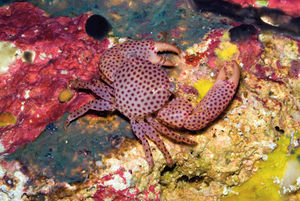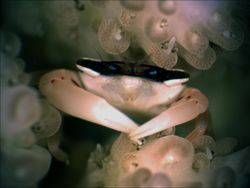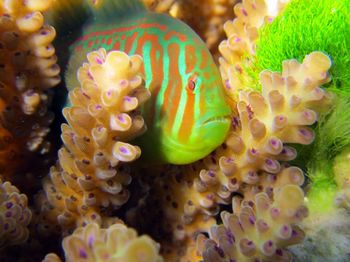Symbiosis
Symbiosis
Symbiosis is a broad term describing the relationship of two dissimilar organisms living together [1]. Often one organism lives inside of another as is the case of corals and zooxanthellae, but can also describe an organism living in very close vicinity (think of the birds who take refuge on hippopotamus' backs).
Symbiosis can be further broken down into more specific relationships such as mutualism in which both organisms benefit from each other, commensalism in which one organism benefits while another is neither harmed nor helped, and parasitism in which one organism benefits at the others expense.
The Coral Probiotic hypothesis, for example, posits that a dynamic relationship exists between coral and the large array of bacteria on their surface, so that when environmental conditions change in the oceans, coral can change which microbial partners they are currently maintaining a relationship with in order to more quickly adapt to those changing conditions. [2]
Examples of Relationships
Corals and Zooxanthellae
One of the greatest examples of symbiotic relationships is that of corals and zooxanthellae. Zooxanthellae are small yellow-green algae that often reside inside corals. Like other algae, zooxanthellae use sunlight to undergo photosynthesis converting carbon dioxide to oxygen and sugars. This is of great advantage to the corals; these sugars supplement or even replace their plankton diet. Then, when the corals release carbon dioxide as waste, it is consumed back by the zooxanthellae. [3]
The relationship between zooxanthellae and corals can be further classified as mutualistic because both organisms benefit. The zooxanthellae consume the coral's carbon dioxide waste as food, in turn producing sugars that serve as food for the corals. Additionally, the presence of carbon dioxide can slow the calcification of the corals, so the zooxanthellae promote coral growth. [3]
Trapeziid Crab-Stony Coral Symbiosis

Symbiotic relationships are also maintained between some types of coral and small organisms. The trapeziid crab-stony coral relationship [5] is an example of a symbiotic relationship wherein a small organism (trapeziid crab) lives on the coral reef and benefits the stony coral by removing any excess sediment that falls on the reef. Sedimentation on reefs has been steadily increasing worldwide, but it is detrimental in that it inhibits growth of the coral and accelerates tissue bleaching. In return, the coral offers a few polyps to the crabs as a source of nutritional value for their efforts in cleaning up the reef, in addition to shelter from predation. A healthy coral should have no problem recovering from the trade off of a few polyps. [6] Therefore, the delicate symbiosis existing between the two species must be maintained to support the existence of both species.

In a field experiment conducted at UC-Santa Barbara, Stewart et. al transplanted sections of stony coral with trapeziid crabs, leaving control transects of the reef free of the tiny crabs. Sedimentation was not enhanced as part of the researchers. Results showed that all corals outplanted with crabs survived, while 45-80% of those outplanted without crabs died (bleached) within a month. Those sections of the coral bleached were without crabs. These results suggest that trapeziid crabs play a crucial role in maintaining the health of the reef, not only for the coral itself, but also the other organisms within the reef [7]
Case Study: Coral and Goby Symbiosis: Defense against Invasive Seaweed

Similar to their constant, encroaching battle with sediment, corals must fight off noxious seaweed in a war for ocean space. Scientists at the Georgia Institute of Technology have discovered that when staghorn species Acropora nasuta detect certain chemical signitures from seaweed, they call on two species of gobies, the broad-barred goby and the redhead goby, whose job is to respond to the chemical signal released by the coral and consume/remove the excess seaweed [9]. In an experiment aimed to elicit this phenomenon, Dixson et. al introduced either turtleweed seaweed or nylon (to mimic the physical structure of turtleweed) to the staghorn coral. Within 3 days, the staghorn colonies infested with seaweed saw 30% less seaweed than before. In this way, the gobies effectively reduced the potential damage to the coral by up to 80% [9]. It is significant to note that the gobies did not respond and remove the nylon when the coral was flanked by its masses, because the coral did not detect the chemical signature from seaweed to start the chain of their own releasing of chemicals. Additionally, it was found that after consuming the toxic seaweed, the toxicity of the predatory broad-barred goby increased as well. The broad-barred goby secretes a toxic mucus in its own defense. [10]
References
- ↑ "Symbiosis." Merriam-Webster Online. Web. 4 Jan. 2013.
- ↑ Reshef, L., Koren, O., Loya, Y., Zilber-Rosenberg, I. and Rosenberg, E. (2006), The Coral Probiotic Hypothesis. Environmental Microbiology, 8: 2068–2073. doi: 10.1111/j.1462-2920.2006.01148.x
- ↑ 3.0 3.1 Strykowski, Joe and Rena M. Bonem. Palaces Under the Sea. Crystal River, FL: Star Thrower Foundation, 1993, p. 10-12. Print.
- ↑ Trapeziid Crab. N.d. Photograph. Fishchannel.com. Web.
- ↑ 5.0 5.1 *Stewart, Hannah L., Sally J. Holbrook, Russell J. Schmitt, and Andrew J. Brooks. "Symbiotic Crabs Maintain Coral Health by Clearing Sediments." Coral Reefs 25.4 (2006): 609-15. Print.[1]
- ↑ "Coral Crabs." Coral Crabs. N.p., n.d. Web. 23 Apr. 2013.
- ↑ Stewart, Hannah L., Sally J. Holbrook, Russell J. Schmitt, and Andrew J. Brooks. "Symbiotic Crabs Maintain Coral Health by Clearing Sediments." Coral Reefs 25.4 (2006): 609-15. Print.
- ↑ Dixson, Danielle. Goby protecting reef. Digital image. N.p., n.d. Web. <http://blogs.discovermagazine.com/notrocketscience/2012/11/09/corals-summon-gardening-gobies-to-clean-up-toxic-seaweed/#.UXc9CivwL41>.
- ↑ 9.0 9.1 Young, Ed. "Corals Summon Gardening Gobies to Clean up Toxic Seaweed : Not Exactly Rocket Science." Not Exactly Rocket Science. Kalmbach Publishing Co., 9 Nov. 2012. Web. 7 Mar. 2013.
- ↑ Dixon, Danielle L., and Mark E. Hay. "Corals Chemically Cue Mutualistic Fishes to Remove Competing Seaweeds." Science 338.6108 (2012): 804-07. Print.